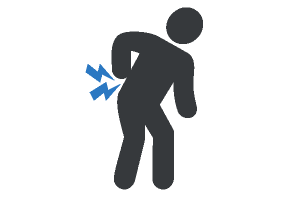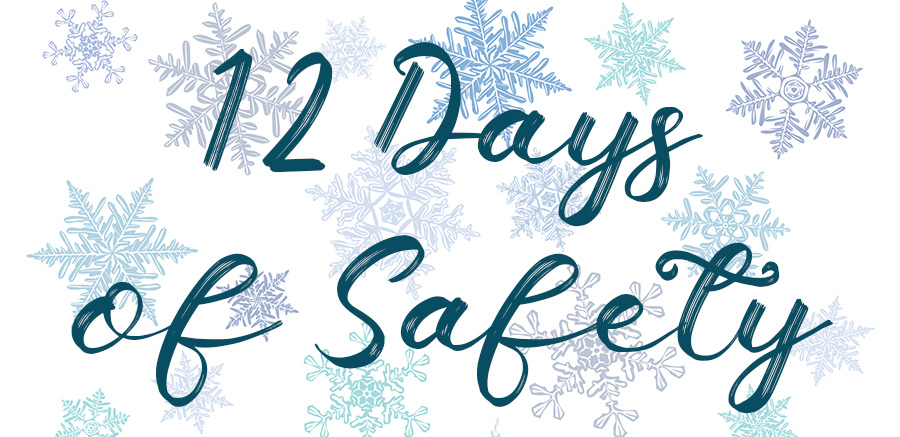Winter and the holiday season bring greater risks of injury and illness. In an effort to help prevent these injuries and keep workers safe, we are sharing 12 occupational health and safety topics over the course of 12 days, December 12-23, 2022. Each topic will include links to free resources from our health and safety partners.
Check back each day for a new health and safety topic!

Roadway Safety is a major concern during the holiday season, with the increases in holiday travel. shipments and deliveries. However, roadway accidents are a leading cause of injury and death year-round. Many occupations involve motor vehicle operation, including agriculture, construction, delivery, transporatation, and gig work.

Workers exposed to cold weather or cold environments without proper protection are susceptible to serious injury, illness, and even death. Outdoor workers and those who work in areas taht are poorly insulated or without heat are susceptible to frostbite, hypothermia, and cold stress. Prevention is key in protecting workers from extreme cold.

The risk of electrical injuries and fire increases in the winter with heaters, extension cords, and lights. But electrical safety is important all year, both in the home and on the job. Many workers are exposed to electrical hazards that can lead to severe injury and death. We have gathered a few resources to help ensure a safe home and workplace.

While ladder safety is important all year, winter and the holiday season bring additional risks, including wet or icy rungs, slippery and uneven ground, and the addition of bulky clothing and boots. Whether using step, straight, or extension ladders – both at home and on the job – there are steps you can take to stay safe and avoid injuries.

Working with equipment, both small and large, is a significant occupational hazard. Improper maintenance, lack of protection, and insufficient worker safety training are just some of the factors that contribute to serious injuries, and even death. Winter creates additional risk with the effects of the cold on equipment. Take a moment to review operation and safety guidelines before operating equipment.

Heavy lifting, repetitive motion, vibration, and poor posture can lead to injury and pain. Ergonomics is the study and implementation of practices and workplace changes to reduce or eliminate these injuries. The holiday season brings increased heavy lifting and repetitive motion for many workers, greatly increasing the risk of injury. Use these resources to help reduce injuries and keep workers safe this season, and all year long.

Fatigue is a significant contributor to workplace injury, and even death. Workers can experience fatigue due to long hours, shift work, stress, physical exhaustion, work environment, and external factors. Although worker fatigue is a serious risk year-round, it can greatly increase during the holiday season due to extra workloads, longer hours, weather changes, stress, and trying to maintain a work-life balance during a busy season. Be aware of the signs of fatigue, and what you can do to stay safe.

Young workers are particularly at risk to injury on the job, due to lack of experience and proper safety training. During the holiday season, many young people enter the workforce as temporary workers in retail, foodservice, delivery, and gig work. Students from rural communities may be returning home to the farm. It’s important to protect young workers, and teach the importance of safety in their future work. Use these resources this holiday season, and all year long, to keep young workers safe and healthy.

Slips, trips and falls are one of the leading causes of occupational injuries and fatalities. Icy or wet surfaces, spills, loose mats and rugs, cluttered workspaces, and low lighting are just some of the potential hazards that can lead to injury. In addition, workplaces may have insufficient training on the proper use of safety equipment. Workplace injuries are preventable. Learn more in these resources from our occupational health and safety partners:

While fire is a serious workplace hazard all year, the risk increases in the winter due to heaters and fuel use, additional lights, and damaged electrical cords. To protect workers, practice fire prevention. Remove potential fire hazards, inspect electrical equipment, properly store combustible materials, maintain fire alarms and extinguishers, educate employees, and have clear, well-marked exits. Use these fire safety resources to help protect your workplace.

Respiratory illness can be a significant hazard in the workplace, where exposure to allergens, airborne particles, chemicals and gasses, infectious disease, and other respiratory hazards can lead to serious illness and death. Winter brings additional respiratory concerns with extreme cold, and the spread of COVID, RSV, and influenza. Holiday gatherings can also increase the risk of transmission of airborne viruses. Proper respiratory protection, masks, and fit testing can help prevent illness and transmission. Use these resources to keep yourself, workers, and families safe and healthy.

Workplace stress is a serious occupational health and safety risk, affecting the physical and mental health of workers. Job-related stress can be due to excessive job demands, work relationships, job dissatisfaction, environment, and many other factors. Stress can lead to physical or psychological illness, aggression or violence, and reduced cognitive ability, increasing the risk of injury. Winter and the holiday season bring additional stresses and increased work demands. The COVID pandemic has also led to a significant increase in workplace stress and mental health issues.


